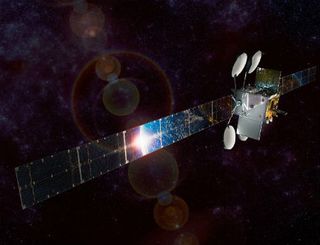Viasat Launches 100 Mbps ‘Platinum’ Tier with Unlimited Data

Just weeks after deeming ViaSat-2, a new high-capacity satellite, ready for service, Viasat has introduced new unlimited, residential data speed tiers, including a top-end offering that delivers up to 100 Mbps downstream.
RELATED: ViaSat-2 Satellite Deemed ‘Ready for Service’
Viasat’s new high-end tier, called Unlimited Platinum 100 and optimized for HD video streaming, carries an introductory price of $150 per month (with in-home WiFi included), and rises to $200 per month after three months. Viasat said Platinum 100’s 100 Mbps downstream is paired with upstream speeds up to 3 Mbps.
Here’s how Viasat’s other unlimited satellite broadband tiers stack up (all come with built-in WiFi):
-Unlimited Bronze 12: Up to 12 Mbps, starting at $50 per month ($70 per month after three months)
-Unlimited Silver 25: Up to 25 Mbps, starting at $70 per month ($100 per month after three months)
-Unlimited Gold 50: Up to 50 Mbps, starting at $100 per month ($150 per month after three months)
Multichannel Newsletter
The smarter way to stay on top of the multichannel video marketplace. Sign up below.
As video streaming goes, Viasat notes that the 12 Mbps typically delivers 360p (small screen quality), compared to 25 Mbps (DVD quality, typically 480p), 50 Mbps (HD, typically 720p), and 100 Mbps (“Full” HD, typically 1080p).
With the new unlimited plans, Viasat is also leaning on new technologies aimed to optimize the bandwidth required for video streaming while also removing hard monthly data caps with unlimited offerings that vary based on location.
Per some of the fine print, once data usage exceeds certain levels on certain speed tiers (40 Gigabytes on the 12-Meg tier; 60 GB on the 25-Meg offering; 100 GB on the 50-Meg tier; and 150 GB on the 100-Meg tier), Viasat “may prioritize your data behind other customers during network congestion.” When such congestion isn’t present, service will continue “based on availability” for customers who exceed their monthly data plan.
RELATED: Viasat to Sunset ‘Exede,’ ‘WildBlue’ and ‘Yonder’ Sub-Brands
In preparation for service on the new ViaSat-2 satellite, Viasat has been testing unlimited plans (along with the video stream management system) on its legacy Viasat-1 platform. By the end of its last financial quarter, about 43,000 subscribers were on those test plans on ViaSat-1. Viasat ended its fiscal Q3 with about 577,000 subscribers.
On the residential end, Viasat is expected to focus its new offerings on underserved areas, including those where DSL speeds leave something to be desired. In addition to supporting services with higher ARPU, Viasat said ViaSat-2 will also support its efforts in other verticals, including in-flight broadband and in the business and government markets.
Viasat is also launching the new tiers on ViaSat-2 amid growing competition in the satellite broadband sector.
EchoStar’s Hughes Networks Systems unit, for example, has reached the preliminary design phase on Jupiter 3, a new broadband satellite that will be capable of delivering speeds of 100 Mbps-plus across a footprint covering the U.S., Canada, Mexico, Brazil and other countries in South America. Hughes is also involved in OneWeb, a platform that will use a constellation of low-earth orbit satellites to deliver services into rural areas, and counts Intelsat, Virgin Qualcomm, SoftBank and Hughes among its investors. Elon Musk’s SpaceX, meanwhile, plans to provide broadband coverage using thousands of low-earth orbit satellites, and put two demonstration satellites into orbit tied to that initiative last week.
"Today's service launch is an important step forward in Viasat's mission to deliver faster internet anywhere,” Mark Dankberg, Viasat’s chairman and CEO, said in a statement. “The innovations we're making across our satellite system allow us to do extraordinary things, from moving the satellite industry up-market by delivering premium services, speeds and plans that give consumers new choices in their internet service provider, to helping bridge the digital divide in the U.S. today."
Viasat’s debut of new data tiers and unlimited plans comes roughly nine months after the launch of ViaSat-2, a Boeing-built high-capacity satellite, from Kourou, French Guiana, aboard Arianspace’s Ariane 5 heavy-lift launch vehicle.
RELATED: ViaSat 2 Launches With Big Broadband Potential
ViaSat-2 was designed to provide 300 Gbps of total throughput, but an antenna issue that emerged following the launch could reduce the data performance of the satellite by about 14% (or 260 Gbps) However, Viasat, which is working to resolve the issue, doesn’t believe it will affect its financial modeling around ViaSat-2.
RELATED: Viasat Downplays Antenna Issue Impacting ViaSat-2’s Data Performance
As ViaSat-2 gets into service, Viasat has entered the construction phase on a new system of three satellites, referred to collectively as ViaSat-3, that will give the company global coverage, and access to more than 1 Terabit per second of network capacity per satellite.
The launch of the first satellite for ViaSat-3 is slated for 2020 and enhance coverage in the Americas, followed a second one for the Europe, the Middle East and Africa (EMEA) region about six months later, and a third that’s planned to provide coverage in the Asia Pacific region.
